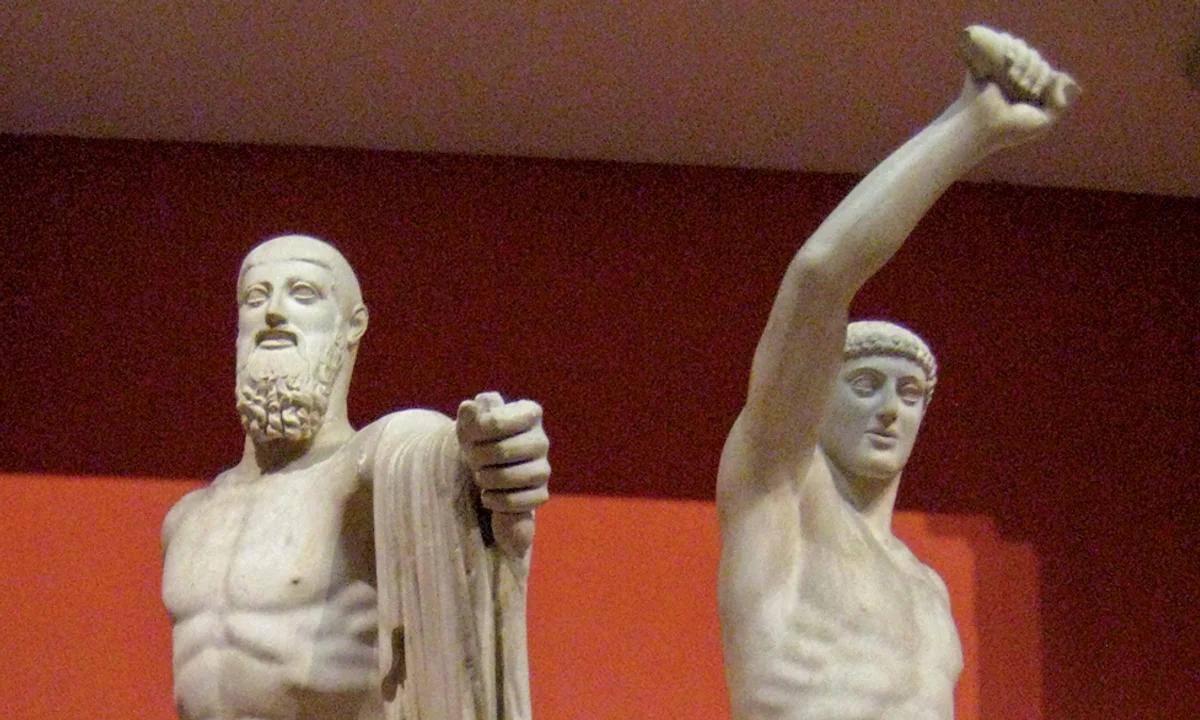Tyran Slayers: Aristogetion and Harmodius Sculpture Group.
Composition
If we look at the composition of the Aristogetion and Harmodius statue group, known as the Tyrant Killers, the two heroes are depicted fighting back to back. On the left, the older Aristogeiton stretches his left hand forward, his Himation thrown over his arm, in a shield-like position. His left leg is thrown forward for a lunge and slightly bent at the knee, while his right leg is placed further back and tense. His right shoulder is given back and he is about to draw his now missing sword from behind with his right hand. The naked statue has a more muscular and ideal body for its age.
On the right, the younger-looking Harmodius is excitedly attacking to make a striking blow, holding a sword with his right hand raised in the air. The statue has its right leg thrown forward, while its left step is further back.
iconography
The sources that give us information about the iconography of this sculpture group are as follows;
- Herodotus 5th century BC 5.62
- Thucydides 5th century BC Historiai: PELLEPONNESIAN WARS 6.56.3
- Aristotle 4th century BC
- Pilinius 1st century AD
In summary, Aristogeiton and Harmodius are close friends. The sons of Pesistratos, a tyrant, assassinated Hippias (547 BC – 490 BC) and Hyparkhos (tyranny 528 BC – death 514 BC) at the Panathenaia Festival, and Hyparkhos died here.
Aristogetion Harmodius Sculpture Group.
Aristogeiton and Harmodius, who are of Eretrian origin from the Tyrant Slayers, are from the Gephyraeans. Herodotus says that this group was from the Phoenicians who accompanied Cadmus on his trip to Boeotia. Thucydides mentions that Harmodios was a good-looking young man and Aristogeiton was a middle-aged Athenian.
Hippias and Hyparchus, the sons of Pesistratos, an Athenian tyrant, took over the city administration after their father’s death. According to some historians such as Herodotus and Thucydides, Hippias is the only one of the brothers who acts as a tyrant.
Hyparchus, one of the brothers who was the tyrant of Athens, was greatly impressed by the young Harmodius, but despite his power, his interest was not reciprocated. Harmodius told this situation to his boyfriend Aristogeiton, who started planning the assassination of the Tyran brothers. He will wait for the Panathenaia festival to assassinate him. The festival day comes. Enraged by his rejection, Hyparchus publicly humiliates and humiliates Harmodius’ sister, who was a basket carrier at the festival. Aristogeiton and Harmodius, who planned the assassination, infiltrated the festival with a group of supporters and hid their weapons in wreaths made of myrtle wood. When it was seen that one of them was intimate with Hyparchus, it was thought that the plan was revealed and the assassination started early.
As a result of the assassination, Hyparchus, one of the Tyran brothers, died and Hippias escaped. Harmodius was also killed, and Aristogeiton, who was captured after escaping for a while, was caught and executed. According to Aristotle, when Aristogeiton was captured, he was released in exchange for giving the names of the other assassins, but he was still killed by Hippias.
Tyran Killers: Style and Dating
We also benefit from ancient sources for the style and dating of the Tyran Killers sculpture group. According to Pilinius, Group 1 of two bronze statues dates back to B.C. It was made by the sculptor Antenor in 510 and erected at the place where the assassination took place, on the road leading to the acropolis. Persian king Xerxes created the statue group representing democracy in B.C. In 490, he took the people of Athens to Persepolis in order to humiliate them. Then Kritios and Nesiotes B.C. In 477, the 2nd Group made 2 bronze statues.
Aristogetion Harmodius Sculpture Group.
Alexander brings the 1st Group bronze statue back to Athens in 330 BC and there are now 4 2 groups of bronze statues in Athens. These two groups of statues cannot be accessed, presumably because they were melted down during the Roman period. A copy must be made before melting.
The statues are presented naked, that is, they are heroized. Although Aristogeiton is depicted as old, he is depicted as muscular. The head and body have classical period features. All stylistic features of Aristogeiton’s head and body were copied from the bronze original made by Kritios and Nesiotes in 477 BC.
The head of Harmodius shows archaic features. B.C. It was copied from a group of bronze statues made by the sculptor Antenor in 510. However, his body has classical period features. In other words, we can say that the bronze made by Kritios and Nesiotes in 477 BC was made by copying the original.
*The original stances of the statues are unknown. There are different descriptions in ceramic drawings. Therefore, we can call these copies variants because their composition has been changed.
Importance:
It is the first example in classical Greek sculpture that reflects a political scene and an actual event. Although Tyran’s assassination was a great service to democracy, some historians say that it was emotional.
